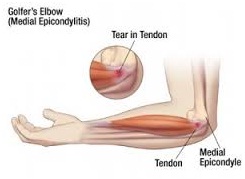Golfer Elbow Causes, Symptoms, Diagnosis and Treatment

What Is Golfer Elbow?
Golfer elbow is tendinosis of the medial epicondyle of the elbow. It is known to cause inflammation in the tendons connecting the forearm and the elbow.
The pain associated with golfer elbow originates in the elbow but may spread to the forearm.
Commonly caused by the overuse of muscles, golfer’s elbow occurs because repetitive use of the arm may cause pulls or tiny tears in the tendon.
Although it is similar to tennis elbow in the sense that both are forms of elbow tendinitis, Golfer’s elbow differs in the location of the initial damage.
While tennis elbow is caused from damage to the tendons outside the elbow, golfer elbow is caused by damaged to the tendons inside the elbow.
Usually, no treatment except proper rest is required. However, if the pain persists, drugs can be sought.
Causes Of Golfer Elbow:
Golfer elbow is caused by damage to the muscles and tendons which control wrists and fingers.
The damage is may be due to:
- Excess or repeated stress
- Improper lifting, throwing or hitting
- too little warm-up before exercise
Activities which tend to lead to development of golfer elbow may include:
- Improper gripping or swinging clubs incorrectly or applying excess force
- Racket sports.
- Using a heavy racket or employing excessive topspin can cause the tendons to pull
- Throwing sports.
- Improper pitching technique may cause damage
- Weight training.
- Lifting weights using improper technique
- Activities involving repetitive bending and straightening of elbow
- Painting
- Raking
- Hammering
- chopping wood
- using a computer
- doing assembly-line work
- cooking
Symptoms Of Golfer Elbow:
The following signs and symptoms are experienced by those who develop Golfer elbow:
- Pain and tenderness
- Pain typically worsens with certain movements.
- Pain may begin in the elbow and spread to the forearm
- Stiffness may lead to inability to make a fist without feeling pain
- Numbness or tingling.
Diagnosis Of Golfer Elbow:
Golfer elbow can be diagnosed via:
- Medical history
- Physical examination
- Evaluating pain and stiffness by applying pressure
- Imaging tests, to rule out other possible complications
- X-ray
- MRI
Treatment Of Golfer Elbow:
The following treatments help in relieving pain and healing Golfer Elbow:
- Resting
- Ice the affected area to help relieve the tingling sensation
- Pain relievers
- ibuprofen (Advil, Motrin IB, others)
- naproxen sodium (Aleve, others)
- Acetaminophen (Tylenol, others).
- Using a brace, to reduce tendon strain
- Stretching and strengthening the affected area
By : Natural Health News




